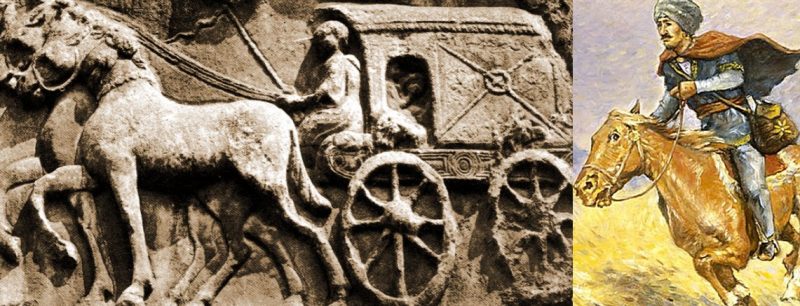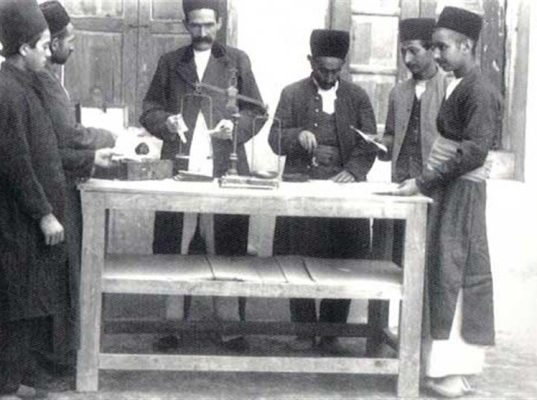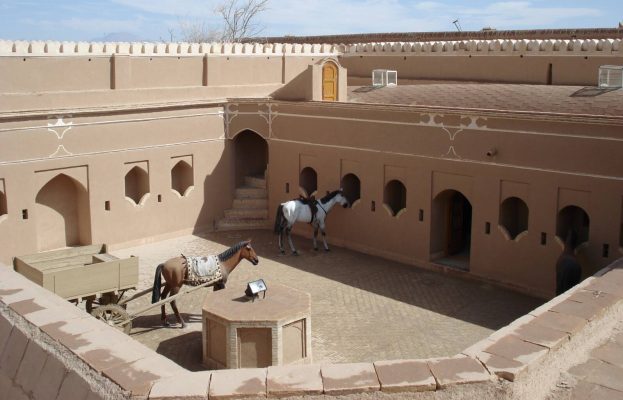The history of the postal systems, when a postal or courier service used to forward messages from one person in one place to another person in another place, begins with the invention of writing and may have been one of the reasons writings was invented.
In this article, we will first go over a quick summary of the history of the mailing system in the world, and then we will discuss the history of Chaparkhaneh and post in ancient Iran.
History of Chaparkhaneh and post in ancient Iran
Writing began in Mesopotamia at least 9,500 years ago and involved the use of clay marks, lumps of baked clay incised with dots or lines representing quantities of goods. A courier could bring a seller token for as many bushels of grain or as many glasses of olive oil, and the seller would ship the tokens back to the buyer with the goods. Think of it as a Bronze Age bill of lading.
Around 3500–3100 BC By the Uruk period, the Mesopotamian trade network had skyrocketed, and they wrapped their clay tokens in thin clay slabs, which were then baked. These Mesopotamian envelopes, called bullae, were designed to prevent fraud so the seller could be sure the correct quantity of goods would reach the buyer. Eventually, the tokens were removed and a tablet with markers used – and then the writing really took off.
Postal system
The first documented use of a postal system – government-sponsored, designated couriers who were trusted to carry messages – was around 2400 BC. In Egypt, pharaohs used couriers to send decrees across the national territory. The earliest surviving piece of mail is also an Egyptian piece of mail, dating to 255 BC. B.C., recovered from the Oxyrhynchus papyri cache.

The same type of courier service was probably used to administer taxes and keep track of distant areas of most empires, such as the Fertile Crescent Persian Empire (500–220 BC), the Han Dynasty in China (306 BC –221 AD), the Islamic Empire (622–1923 AD) in Arabia, the Inca Empire in Peru (1250–1550 AD) and the Mughal Empire in India (1650–1857 AD). In addition, no doubt state-sponsored messages were transported alongthe Silk Road between merchants in different empires, probably since its inception in the 3rd century BC.
The first envelopes that protected such messages from prying eyes were made of cloth, animal skins, or parts of vegetables. Paper envelopes were developed inChina, where paper was invented in the 2nd century BC. Paper envelopes, known as chih poh, were used to hold gifts of money.
The birth of modern mail systems
In 1653, the Frenchman Jean-Jacques Renouard de Villayer (1607–1691) established a postal system in Paris. He set up mailboxes and delivered any letters placed in them if they used the postage-paid envelopes he sold. De Villayer’s business didn’t last long when a sneaky individual decided to put live mice in mailboxes to scare off his customers.
Rowland Hill (1795–1879), a schoolmaster from England, invented the self-adhesive postage stamp in 1837, for which he was knighted. Through his efforts, the world’s first postage stamp system was issued in England in 1840. Hill created the first uniform postage rates based on weight rather than size. Hill’s stamps made a prepayment of postage both possible and practical.
Today, the Universal Postal Union, founded in 1874, includes 192 member countries and sets the rules forinternational mail exchange.
First mail order catalog
The first mail-order catalog was distributed in 1872 by Aaron Montgomery Ward (1843–1913), who sold goods primarily to farmers who had difficulty getting them into the big cities for trade. Ward started his Chicago business with just $2,400. The first catalog consisted of a single 8″ x 12″ sheet of paper with a price list detailing the goods for sale with ordering instructions. The catalogs were then expanded into illustrated books. In 1926, the first Montgomery Ward retail store opened in Plymouth, Indiana. In 2004, the company relaunched as an e-commerce company.
The first automatic mail sorter
Canadian electronics scientist Maurice Levy invented an automatic mail sorter in 1957 that could process 200,000 letters an hour.
The Canadian Postal Department had commissioned Levy to design and supervise the construction of a new electronic, computerized automatic mail sorting system for Canada. A hand-made model sorter was tested at the Ottawa Post Office in 1953. It worked, and in 1956 a prototype encoding and sorting machine capable of handling all the mail produced by the City of Ottawa was built by Canadian manufacturers. It could process mail at a rate of 30,000 letters per hour, with a missing factor of less than one in 10,000 letters.
Iranians and the old post organization
A regular administrative organization to convey the message in Iran was formed during the reign of Darius the Achaemenid due to the vastness of government territory. The administrative system underwent changes with the arrival of Islam in Iran and the rule of Muslims; Thus, a messaging system called the “Divan Barid” transmitted confidential court information to the territories of the Islamic Caliphate.
The printing presses operated regularly and continuously with the establishment of the Safavid dynasty. What is important in the pre-Qajar period in the information administrative system is its monopoly in the hands of the government; That is, sending and receiving messages and letters belonging to the court and its affiliated institutions.
The people were thus unable to use the messaging system and organization, and no structure was in place to meet the needs of the people in this regard. If a message was conveyed among the people, it was only based on the tactics and methods they had devised, and of course, it did not have a regular structure. This situation changed during the Qajar period with the arrival of Western culture and civilization, familiarity with Europe, and the expansion of the needs of the people.
The condition and salaries of Chapar mailmen
The idea of founding the post was raised during the reign of Fath Ali Shah, which apparently did not continue. According to Hossein Mahboubi Ardakani in his book “History of New Civilization Institutions in Iran”, Iranians were unfamiliar with the new post at that time so much that the Qajar Shah did not think such an organization existed. Haj Mirza Abolhassan Khan Shirazi “had seen the post in Europe, explained it to Fath Ali Shah, and the Shah thought that he was making fun of him, wanted to kill Haji, until Sergur Ozli confirmed his words.”

The Qajar government during the Amir Kabir era, in line with other reform measures in the economic, social, and military fields, also paid attention to its post and generalization. Amir Kabir, according to an announcement in the newspaper “Vaqaye Etefaqiyeh”, ordered that government printing presses (Chapar) be made available to the people.
He set up regular printing house networks (Chaparkhaneh) and in a decree, ordered the Chapars to travel twice a month, one at the beginning and the other in the fifteenth month to and from the eight main regions of the country: Azerbaijan, Fars, Guilan, Mazandaran, Kerman, Khorasan, Astarabad and Kermanshah. An announcement in this regard has been published in the second issue of “Vaqaye Etefaqiyeh” newspaper. “People who want to send mail must bring it to the Chaparkhaneh and hand it over to the supervisors. On the day Chapar arrived, whoever had the mail would pick it up and the delivery of the mail to the people would not be delayed.”
The work and occupation of these chapars were difficult. In winter and summer, they had to travel long and sometimes arduous distances in a hurry, delivering and returning messages quickly. In case of delay, they had to have a convincing reason, otherwise, they would be reprimanded. Mary Schill, the wife of the British sovereign minister in Iran during the reign of Nasser al-Din Shah, referred to the condition of these chapars in her travelogue and wrote: “Wrapped in furs and hats, they have to travel the 5 km route between Tehran and Erzurum in ten days, and stop after more than two days, and while their eyes are close to blindness due to extreme fatigue, insomnia, and cold burning, they return to Tehran by the same route. If their travel time exceeds ten days and they cannot give a valid excuse for their delay, they will be held accountable.”
Despite all these problems, they did not have young, fresh horses which made their job more difficult; Also, their meager wages and incomes did not match the hardships of the job.
Mary Shell mentions a Chapar, who was very skilled in his work, and had become very famous in this job. She wrote of “Malek Muhammad-Beyk” who could manage to travel the 1200 km route in just 7 days.” Despite all this, the salary of these high-speed Chapars was very low and did not exceed one lira a year.
The first head of Chaparkhaneh in Qajar
The new post, as it is seen today, was not established until the time of Amir Kabir and even until the arrival of the Belgians in Iran, but the activity of Chaparkhaneh and Chapars, which was the most important communication system in the past, continued on a regular and extensive basis.
Amir Kabir removed the post and the messaging system from the monopolies and made it universal. The first head of the Chaparkhaneh was a person named “Shafi Khan Chaparchibashi” who was nicknamed “Bashir al-Dawla” according to his position. After his death in the first year, several people took charge of this work, until, in the year 1250, Amin al-Mulk became in charge of Chaparkhaneh.
He announced a special uniform and badge for all government Chapars in the “Iran” newspaper; Shortly afterward, the use of stamps and the amount of chaparral service tariffs became known to the people. Previously, stamps were not used for letters, and Chapars only stamped letters. Officials and post offices used to seal letters with colored stamps of various designs and with different monetary values.
The new post of Iran and the Austrian order
Amin al-Mulk served as the head of Chaparkhaneh until Nasser al-Din Shah, on a trip to Europe, employed an Austrian named Gustavarie in Exberg as post manager. Gustavarie came to Iran and after a while, he started his activities by holding a training class to train employees, because the Iranians were not familiar with the principles of the European post system and it was necessary to set up such a class in which only twelve people were accepted. They learned to read Latin words on envelopes and postal items, as well as how to work at post offices. The Austrian agent then put other things on the agenda, such as uniforms for correspondents, the preparation of stamps, and the establishment of a test post service between Tehran and Shemiran.

According to Mahboubi Ardakani in the book “History of New Civilized Institutions”, the Iranian Post operated regularly during Gustavarie’s activity. “Trips to Rasht and Tabriz to be informed about the existing obstacles and most importantly the preparation of postal regulations and the creation of stamps and branches for selling them in some parts of the country, the preparation and installation of a post office box in Tehran which has become popular as a result of postage use” were named among his activities.
Postmen and their trumpets
The way postmen and Chapars worked in the time of Gustavarie was as follows: They would put the letter in a saddlebag which was tied to their horse. Upon arriving at the destination, they would announce their arrival by playing the trumpet. Then, they would give the letters to the receivers, and if it was an unmarked letter, they would personally stamp it in exchange for money.
The Iranian government, with its extensive discipline in postal and consignment affairs, informed the International Postal Union (ICU) office in Switzerland that it wanted to become a member of the union. The government’s request was soon implemented. Iran joined the General Post Union of the world on 11 Ramadan 1296.
The name of the post office was changed to “Ministry of Post” by the order of Nasser al-Din Shah. Nasser al-Din Shah once again left the post to Mirza Ali Khan Amin al-Dawla. According to historical sources, Amin al-Dawla established fixed working hours for his subordinate departments and pensions for their employees. There was a special order in terms of receiving and delivering letters and postal deposits, certified by Nazim al-Islam Kermani and Edward Brown, so that the mail would reach its destination (Kerman) in eight days and return to Tehran. The government also paid an annual fee to repair and procure Chaparkhaneh equipment for government roads and some supplies for the Chaparkhaneh horses. For example, to each Chaparkhaneh, 20 tomans were paid in cash along with ten Kharvar of grain and ten Kharvar of straw.
Mirza Ali Khan Amin al-Dawla employed three Belgians named Noz, Prime, and Engels to manage the customs of Iran. Noz later became Minister of Posts and Customs services. The Belgians established a proper order in the post office which was maintained for a long time. The post office was separated from customs clearance during the time of Mohammad Ali Shah Qajar. The Ministry of Post was in fact one of the six ministries that first emerged to run the affairs of the country. The name of this ministry was changed to the Ministry of Post and Telegraph with the invention of the telegraph and to the Ministry of Post, Telegraph and Telephone with the arrival of the telephone in Iran.
The first Chapar vehicles
Chapars first shipped horses and camels and later carts. Horses and carts also belonged to the people who had contracted the post. Jafar Shahri mentions these postal carts in his book “Old Tehran” and writes: “This cart was also similar to commercial carts, except that in one day it would go up to 24 Farsakh, and it did not stop except for changing horses and eating and resting temporarily, and it was a necessity to always have two or more policemen with them to protect the postal cargo.”
For this reason, Moin al-Mulk also advised the provincial chiefs to set up good finances; This, however, was not the case everywhere, as Mary Schill has pointed out. Henri René Dalmani, a French tourist and antiquarian who traveled to Iran at the beginning of the reign of Mohammad Ali Shah, writes in his travelogue “From Khorasan to Bakhtiari”: “In addition, concluding a contract for the transportation of goods and travel equipment with the Chaparkhaneh operators is not without its problems. In the Chaparkhaneh, all kinds of vehicles were scattered in the middle of the yard and we were allowed to choose one of them. The freight rate is not fixed and depends on the wishes of the head of the Chaparkhaneh. Generally, every passenger has the right to carry 15 kilos, which is a very small amount.”
Stamps; A sign of independence
Using stamps was not common in the beginning. Chaparkhaneh officers used only stamps for letters and postal packages. According to historical sources, the prevalence of stamps in Iran and the familiarity of Iranians with it dates back to the time of the British Post on the southern coast. The manager of the Chaparkhaneh of Iran, imitating that work, arranged a stamp for the Iranian post.
According to Mahboubi Ardakani, he ordered a series of stamps for the Iranian Post which were printed at the Bard printing house in Paris. The lion and the sun were stamped on it and the price was written in the four corners of the stamp. Morteza Ravandi writes in his book on the social history of Iran: “In the year 1285, a delegation left Tehran for Paris to negotiate with the French Ministry of Posts and Telegraphs to study and order stamps. Finally, a person named ‘Bar’ prepared a few examples.”

These serrated stamps, which were printed in Paris, according to Ali Asghar Shamim in the book “Iran during the Qajar dynasty”, were not popular in Iran. According to the regulations laid down by the Austrian Gustavrie, postage was paid on the basis of the weight of the letters and the price of the mailings was in accordance with the rules of the Postal Union. Letters without a stamp were therefore not sent. These stamps were small pieces of rectangular paper with the symbol of the lion and the sun, the price of which was printed in the middle of the stamp in Latin and French, and there were four categories; One Shahi for black, two Shahi for blue, four Shahi for red, eight Shahi for green.
The first series of Iranian stamps that was officially used in the post is called the “Bagheri Stamp” series. New stamps with a photo of Nasser al-Din Shah were later issued in these categories; One Shahi for purple, two Shahi for green, five Shahi for red, and ten Shahi for blue. The emblem of the lion and the sun below and the king’s face on it were engraved on these stamps. The lion was removed from the stamps shortly after and the sun remained. Also, under the sun was written the phrase “forbidden countries of Iran”. These stamps became known as the “Nasiri stamp”.
After a while, stamp printing became a symbol of power. Just as coinage in the past and the printing of banknotes by the ruler were a sign of independence, the printing of stamps was a sign of power and rebellion against the government because it was as limited as coinage and printing of banknotes within the government’s authority. When Abdul Hussein Lari revolted in Lar and raised the banner of independence, he issued a postage stamp dedicated to his own territory. Also, when the Belgian advisers took over the Iranian post, one of them, Victor Castini, became in charge of the Khorasan post and customs services. He ordered a series of stamps with two letters V.C. to be printed, removing all government insignia. This, which was against international law, was considered a sign of his arbitrariness and was strongly protested.
Final thoughts
The Iranians were the first nation to establish thetransportation of goods by mail under the title “Chapar” about 2500 years ago during the Achaemenid period. The Iranians founded and organized this administrative organization a long time ago so that all communication affairs of Iran could be done through it.



